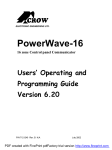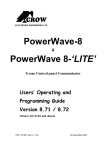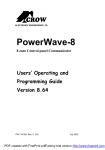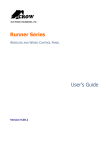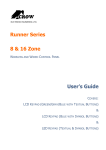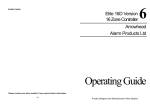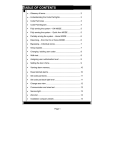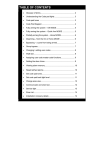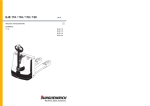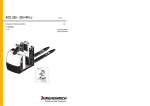Download PowerWave 8 User Guide - Australian Security Company
Transcript
OUTPUTS: Output 1 _____________________ Output 2 _____________________ Output 3 _____________________ Output 4 _____________________ Siren Time: ____ (minutes) COMMUNICATION OPTIONS: Monitoring Domestic Power Wave - 8 Speech SERVICING: Yes No Can your system be serviced by another technician? 8 Zone Alarm Panel If yes, Installer Code __________ SERVICING NOTES: USER GUIDE 25-Oct-2001 Please contact your alarm installer if you require further information. MONITORING COMPANY: About your Alarm System Thank you for choosing to protect your premises with an ‘PowerWave8’ (PW8). In doing so you have invested in the most advanced and adaptable panel on the market. As you become familiar with your PW-8, *ask your installer about the incredible program options and additional expandability of your PW-8 Alarm Controller. Your new panel is ready to give you years of trouble free operation and can be custom programmed to your specific needs. Add on features like the RX-40 wireless receiver card to operate any of the 4 outputs and the arm / disarm of your panel with up to 8 key fob wireless pendants, or add wireless detectors at any stage. The auto dialler on your panel can be set up to send high speed signals to a monitoring station and / or "domestic dial" sending an Alarm tone to any or all of the 4 possible phone numbers The Keypad Your PW-8 Alarm Controller has been designed with you in mind. Clearly named backlit keys may cost a little more but mean you don't have to remember multiple key combinations to achieve a result. As with everything about the PW-8, even key functions can be fine tuned to your specific needs. Please ask your installer. Arming Your System Press the [ARM] to arm your system, the Armed light will come on. Your panel will begin beeping it's exit delay. During this time it is optional to press the [ARM ] key again to disarm. (to prevent accidental arming, the panel can be programmed to require a code to arm. To do so enter your code followed by the [ENTER] key). Disarming Enter your 1 to 6 digit code then press the [ENTER] key. If your system has the wireless receiver installed, your system can also be armed or disarmed with your remote key fob pendant. Panic This special key's function is best programmed by your installer to suit your individual situation. Most commonly it is used in a panic situation to sound only the outside siren and perhaps call a monitoring station. A panic command can be instant or your installer can program a 2 second delay to prevent false alarms. (A Panic can also be triggered by a dedicated Monitor Mode Keypad or a Remote Control button programmed as instant or delayed panic). The CONTROL Key Account Number_________________ Passcode______________ Phone____________________ USER CODES: Master Code 1. Code__________ Name_____________________ 2. Code__________ Name_____________________ 3. Code__________ Name_____________________ 4. Code__________ Name_____________________ 5. Code__________ Name_____________________ 6. Code__________ Name_____________________ 7. Code__________ Name_____________________ 8. Code__________ Name_____________________ 9. Code__________ Name_____________________ 10. Code__________ Name_____________________ ZONES: Delay Zone 1 _____________________ ___ Zone 2 _____________________ ___ Zone 3 _____________________ ___ Zone 4 _____________________ ___ Zone 5 _____________________ ___ Zone 6 _____________________ ___ Zone 7 _____________________ ___ Zone 8 _____________________ ___ Monitor Mode ¸ Chime Another special key that can be programmed to control a number of functions. 1) Chime Zone Control: A Chime Zone is a detector that can be part armed while you are home but working in another part of the building. It can be programmed to operate a buzzer or light to let you know you have a visitor. Press the [CONTROL] key (Program and System LED's will be on steady). EVENT DEVICE INDICATOR STATUS WIRELESS ZONE LOW BATTERY Wireless PIR Zone 1-8 LED's 1-8 Flashing REMOTE CONTROL LOW BATTERY Remote Control Button 1-8 TROUBLE LED's 1-8 On Steady Flashing PANIC BUTTON (BUTTONS 1&3 PRESSED TOGETHER) Keypad Panic SYSTEM Flashing FIRE ALARM (BUTTONS 4&6 PRESSED TOGETHER) Keypad Fire SYSTEM AREA A Flashing Flashing Press the [PROGRAM ] key (Program LED will flash) indicating that Chime Zone is disabled. MEDICAL ALARM (BUTTONS 7&9 PRESSED TOGETHER Keypad Medical SYSTEM AREA B Flashing Flashing To enable Chime Zone Press <CONTROL> and <PROGRAM> key again. PENDANT PANIC Radio Key User 1-8 SYSTEM LED's 1-8 Flashing Flashing Note: When the system is armed it changes to become a full alarm zone. ARMED A Area A Armed AREA A LED On Steady ARMED B Area B Armed AREA B LED On Steady MONITOR MODE A Area A Monitor Mode ON AREA A LED Flashing MONITOR MODE B Area B Monitor Mode ON AREA B LED Flashing DURESS ALARM Duress Alarm TROUBLE AREA A & B On Steady Flashing Installation Notes: INSTALLTION COMPANY: Company ________________________________________ Technician___________________ Installation Date__________ Phone_________________ 2) Output Control: Outputs are programmable contacts on the panel that can be used to switch power or external devices on or off. Press the [CONTROL] key (Program and System LED's will be on steady). Press the number key corresponding to the output you wish to turn on i.e.output 3 turns on water heating. Press the 3 key the 3 LED will illuminate indicating the output is on. Press the [ENTER] key to return to normal keypad function. To check what outputs are on simply press the [CONTROL] key again, LED 3 will be illuminated pressing the 3 key again will toggle the output off. Press [ENTER] to return keypad to normal. The MONITOR Key Monitor mode allows you to monitor areas you will not be in at night. Preselected zones or sensors can be armed with this key while you are in the building and programmed to go into your choice of alarm states if triggered. As with everything else on the panel this too can be tailored to your needs. For example you may wish to have the detectors in your garage and lounge sound only a little buzzer by your bed at night to warn you of an intruder. To use this feature press the [MONITOR] key and if programmed to do so, the exit delay will sound. The armed light on the keypad will flash. To disarm, press the [MONITOR] key again. The PW-8 can be programmed to require your user code and pressing [ENTER] to disarm. The EXCLUDE Key This key allows you to temporarily exclude or by-pass zones of your choice when arming your panel. The excluded zones will go back to normal the next time you disarm the panel (except 24 Hour zones which must be manually re-included). A typical example would be if you wanted to let your pet run around in the garage when your system is armed, you could choose to exclude that detector (say Zone 1) from the system. To exclude zone 1, key in the following sequence: [EXCLUDE] (Ready/Exclude and Program LEDs will illuminate). 1 [ENTER] When the [ENTER] key is pressed the Ready/Exclude LED will flash to indicate the exclude function is active before arming, any number of zones may be excluded in this manner. Key in [EXCLUDE] again to add or remove excluded zones. Key the 1 again and zone 1 will be included. <ARM> NOTE: 24 hour zones (for example smoke detectors) will remain excluded until they are manually included again. All other excluded zones will return to normal "included" mode automatically the next time the panel is armed. It is advisable to vacate the secured area before the exit delay expires. If the System light is on, but no other Zone lights are—there are no current System alarms. Arming/Disarming or reviewing the Memory will turn it off. When viewing the memory by pressing the [MEMORY] button, the first thing that will always be displayed are CURRENT SYSTEM FAULTS. Below here are the System fault indications: Zone LED u ç é è ê ë í ì The PROGRAM Key This key is used to get into program mode. The PW-8 can accept as many as 10 different user codes of 1 up to 6 digits in length. Your installer can set you up to enter your code at user code 1 (Master code). You will now be able to add, delete or change codes for other users. To add a new user code: By default only the master code has access to change add or remove codes. Any new codes added will be able to arm, disarm and put either area of the panel into monitor mode. User codes can be limited in their levels of Access if required. See your installer. Battery Low Mains Failure Telephone Line Failure Wireless Detector Battery Low Remote Control Battery Low Wireless Detector Supervision Failure Zone Inactivity Timeout Spare Following the display of current system alarms the panel will then sequence through the 127 historical memory events starting at the most recent event. VIEWING THE MEMORY The ENTER Key This key is used to accept a series of button presses. Note: If you make a mistake while entering your code, press the [ENTER] key and start again. System Fault EVENT DEVICE INDICATOR STATUS ACTIVATION Zones 1-8 LED's 1-8 On Steady EXCLUDE Zones 1-8 READY/EXCL LED's 1-8 On Steady On Steady DETECTOR TAMPER (SHORT CIRCUIT) Zones 1-4 TROUBLE LED's 1-4 Flashing On Steady DETECTOR TAMPER (OPEN CIRCUIT) Zones 5-8 TROUBLE LED's 5-8 Flashing On Steady CABINET TAMPER Cabinet or External Siren TROUBLE Flashing LOW BATTERY Alarm Backup Battery SYSTEM LED 1 On Steady On Steady MAINS FAILURE Alarm Mains Supply SYSTEM LED 2 On Steady On Steady continued over leaf . . . Making sure the panel is not armed, key in the following sequence: This event memory is displayed via the keypad with the most recent event shown first and subsequent events following in descending order from newest to oldest. Each event is separated by a beep tone. There are a number of events which are stored in memory which do not have a specific indicator associated with them such as Panic and Duress. Other events such as tampers and low battery are shared across many devices. For this reason the following table has been created. This table details which indicator lights correspond to which events in memory. To enter View the EVENT MEMORY Press the [MEMORY] button. The last 127 events will be played back on the keypad LEDs displayed sequentially at 2 second intervals from the most recent event backwards. To get to a specific event rapidly press the [MEMORY] key repeatedly and the memory display will be sped up accordingly [PROGRAM ] mastercode [ENTER] The program light will come on steady, indicating readiness to accept new programming. To load, for example, user code 3 with a code 4321, key in the following sequence: Add further user codes from 2 up to 10 if required. [PROGRAM ] 3 [ENTER] If there is an existing code already in that address it will be flashed back on the key pads LED display. Entering the new code will delete the old and the new code will be flashed back to you. 4321 [ENTER] The panel will give 3 short beeps to indicate correct entry or 1 long tone if not accepted. To remove or clear a user code number e.g. user 3, key in the following sequence [PROGRAM ] 3 [ENTER] [EXCLUDE] [ENTER] To exit out of program mode key To exit memory mode press [ENTER] [PROGRAM ] [ENTER] Note: on the LED display 0 is indicated by LED 'A' and 9 by LED 'B'. Event Memory Your PW-8 alarm panel has an event memory which stores, the 127 most recent events including all alarm events and system events such as mains failure etc as well as sets. The System LED will flash when an event occurs e.g. "mains failure". When the event is cleared "mains returns", the system LED will remain steady. To clear this indicator press [MEMORY] or it will simply clear next time you arm the panel. The Trouble LED will flash when an alarm occurs e.g. Tamper Alarms. When the alarm is cleared, by entering a valid code the Trouble LED will turn off. If the reason for the alarm is not cleared the Trouble LED will remain on solid until the cause is found and cleared fully.





